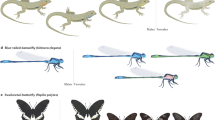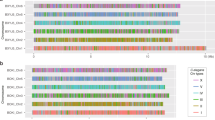Abstract
Sex determination and differentiation are inherently fascinating to both layperson and geneticist. Major advances have accelerated interest in the molecular genetic events mediating these processes in nematodes, flies, mice and humans. Far less attention has been paid to those organisms, particularly reptiles, where sex is determined by environmental cues. However, recent experimental evidence suggests that the two modes of sex determination may not only share common genetic elements, but may also be regulated by similar mechanisms. We argue that the ability to manipulate sex by temperature provides a particularly suitable model for exploring the molecular basis of this fundamental biological process.
Similar content being viewed by others
References
Baker, B. S., 1989. Sex in flies: the splice of life. Nature 340: 521–524.
Baker, B. S., K. C., Burtis, T. J., Goralski, W., Mattox & R. N., Nagoshi, 1989. Molecular genetic aspects of sex determination in Drosophila melanogaster. Genome 31: 638–645.
Bell, L. R., E. M., Maine, P., Schedl & T. W., Cline, 1988. Sex-lethal, a Drosophila sex determination switch gene, exhibits sex-specific RNA splicing and sequence similiarity to RNA binding proteins. Cell 55: 1037–1046.
Belote, J. M., 1989. The control of sexual development in Drosophila melanogaster: genetic and molecular analysis of a genetic regulatory hierarchy — a mini review. Gene 82: 161–167.
Berta, P., J. R., Hawkins, A. H., Sinclair, A., Taylor, B., Griffiths, P. N., Goodfellow & M., Fellows, 1990. Genetic evidence equating SRY and the testis determining factor. Nature 348: 448–450.
Bourne, H. R., D. A., Sanders & F., McCormick, 1991. The GTPase superfamily: conserved structure and molecular mechanism. Nature 349: 117–127.
Bull, J. J., 1980. Sex determination in reptiles. Quart. Rev. Biol. 55: 3–21.
Bull, J. J. & R. C., Vogt, 1979. Temperature-dependent sex determination in turtles. Science 206: 1186–1188.
Bull, J. J., D. M., Hillis & S., O'Steen, 1988. Mammalian ZFY sequences exist in reptiles regardless of sex-determining mechanism. Science 242: 567–569.
Bull, J. J., R. G., Moon & J. M., Legler, 1974. Male heterogamety in kinosternid turtles (genus Stavrotypus). Cytogenet. Cell. Genet. 13: 419–425.
Burgoyne, P. S., 1989. Thumbs down for zinc finger? Nature 342: 860–862.
Cattanach, B. M., 1961. XXY mice. Genet. Res. 2: 156–158.
Cattanach, B. M., 1962. XO mice. Genet. Res. 3: 487–490.
Charnier, M., 1966. Action de la temperature sur la sex-ratio chez l'embryon d'Agama agama (Agamidae, Lacertilien). Soc. Biol. Quest Af. 160: 620–622.
Cline, T. W., 1988. Evidence that sisterless-a and Sisterless-b are two of several discrete ‘numerator elements’ of the X/A determination signal in Drosophila that switch Sxl between two alternative stable expression states. Genetics 119: 829–862.
Deeming, D. C. & M. W. J., Ferguson, 1988. Environmental regulation of sex determination in reptiles. Phil. Trans. R. Soc. Lond. B 322: 19–39.
Deeming, D. C. & M. W. J., Ferguson, 1989. The mechanism of temperature dependent sex determination in crocodilians: a hypothesis. Amer. Zool. 29: 973–985.
Deeming, D. C. & M. W. J., Ferguson, 1990. Morphometric analysis of embryonic development in Alligator mississippiensis, Crocodylus johnstoni and Crocodylus porosus. J. Zool. 221: 419–439.
Demas, S., M., Duronslet, S., Wachtel, C., Caillouet & D., Nakamura, 1990. Sex-specific DNA in Reptiles with Temperature Sex Determination. J. Exp. Zool. 253: 319–324.
Dreyfuss, G., L., Philipson & I. W., Mattaj, 1988, Ribonucleoprotein particles in cellular processes. J. Cell. Biol. 106: 1419–1425.
Eicher, E. M. & L. L., Washburn, 1986. Genetic control of primary sex determination in mice. Ann. Rev. Genet. 20: 327–360.
Ferguson, M. W. J. & T., Joanen, 1983. Temperature-dependent sex determination in Alligator mississippiensis. J. Zool., London 200: 143–177.
Gubbay, J., J., Collignon, P., Koopman, B., Capel, A., Economou, A., Munsterberg, N., Vivian, P.N., Goodfellow & R., Lovell-Badge, 1990. A gene mapping to the sex determining region of the mouse Y chromosome is a member of a novel family of embryonically expressed genes. Nature 346: 245–250.
Harry, J. L. & C. J., Limpus, 1989. Low temperature protection of marine turtle eggs during long distance relocation. Aust. Wildl. Res. 16: 312–320.
Harry, J. L., K. L., Williams & D. A., Briscoe, 1990. Sex determination in loggerhead turtles: differential expression of two hnRNP proteins. Development 109: 305–312.
Harry, J. L., 1991. An Investigation of the Mechanism of temperature dependent determination in the turtle Caretta caretta, Linnaeus 1758 in Ph.D. Thesis, Macquarie University, Sydney, Australia.
Harry, J. L. & K. L., Williams, 1991. Differential Growth of Male and Female Urinogenital Systems of Caretta caretta, Within the Sex-Determining Period. J. Exp. Zool. 258: 204–211.
Hodgkin, J., 1987. Sex determination and dosage compensation in Caenorhabditis elegans. Ann. Rev. Genet. 21: 133–154.
Hodgkin, J., 1989. Drosophila sex determination: a cascade of regulated splicing. Cell 56: 905–906.
Hodgkin, J., 1990. Sex determination compared in Drosophila and Caenorhabditis. Nature 344: 721–728.
Jacobs, P.A. & J.A., Strong, 1959. A case of human intersexuality having a possible XXY sex determining mechanism. Nature 183: 302–303.
Jones, K. W. & L., Singh, 1981. Conserved repeated DNA sequences in vertebrate sex chromosomes. Hum. Genet. 58: 46–53.
Joss, J. M. P., 1989. Gonodal development and differentiation in Alligator mississippiensis at male and female producing incubation temperatures. J. Zool. 218: 679–687.
Kent, M. G., K. O., Elliston, W., Schroeder, K. S., Guise & S., Wachtel, 1988. Conserved repetitive DNA sequences (Bkm) in normal equine males and sex-reversed females detected by in situ hybridization. Cytogenet. Cell Genet. 48: 99–102.
King, M., 1977. The evolution of sex chromosomes in lizards, pp. 55–60, in Evolution and Reproduction, edited by J., Calaby & H., Tyndale-Biscoe. Aust. Acad. Sci., Canberra, Australia.
Koopman, P., J., Gubbay, J., Collignon & R., Lovell-Badge, 1989. Zfy gene expression patterns are not compatible with a primary role in mouse sex determination. Nature 342: 940–942.
Koopman, P., J., Gubbay, N., Vivian, P.N., Goodfellow & R., Lovell-Badge, 1991. Male development of chromosomally female mice transgenic for Sry. Nature 351: 117–121.
Levison, G., J. L., Marsh, J. T., Epplen & G. A., Gutman, 1985. Cross-hybridizing snake satellite, Drosophila and mouse DNA sequences may have arisen independently. Mol. Biol. Evol. 2: 494–504.
Limpus, C. J., P. C., Reed & J. D., Miller, 1985. Temperature-dependent sex determination in Queensland sea turtles: intraspecific variation in Caretta caretta, pp. 343–351 in Biology of Australasian Frogs and Reptiles, edited by G., Grigg, R., Shine and H., Ehmann. Royal Zoological Society of New South Wales, Sydney, Australia.
Lin, Y-S. & M. R., Green, 1989. Similarities between prokaryotic and eukaryotic cyclic AMP-responsive promoter elements. Nature 340: 656–659.
Madl, J. E. & R. K., Herman, 1979. Polyploids and sex determination in Caenorhabditis elegans. Genetics 93: 393–402.
Mardon, G., R., Mosher, C. M., Disteche, Y., Nishioka, A., McLaren & D. C., Page, 1989. Duplication, deletion and polymorphism in the sex-determining region of the mouse Y chromosome. Science 243: 78–83.
Mattaj, I.W., 1989. A binding consensus: RNA-protein interactions in splicing, sRNPs, and sex. Cell 57: 1–3.
Mclaren, A., 1990. What makes a man a man? Nature 346: 216–217.
McLaren, A., E., Simpson, K., Tomonari, P., Chandler & H., Hogg, 1984. Male sexual differentiation in mice lacking H-Y antigen. Nature 312: 552–555.
McLaren, A., 1988. Sex determination in mammals. Trends Genet. 4: 153–157.
Miller, L. M., J. D., Plenefisch, L.P., Casson & B.J., Meyer, 1988. xol-1: A gene that controls the male modes of both sex determination and X chromosome dosage compensation in C. elegans. Cell 55: 167–183.
Miller, J. D. & C. J., Limpus, 1981. Incubation period and sexual differentiation in the green turtle, Chelonia mydas, pp. 66–73 in Proc. Melbourne Herpesvirus Symposium, edited by C. B., Banks and A. A., Martin. Zoological Board of Victoria, Melbourne, Australia.
Minoo, P., W., Sullivan, L. R., Solomon, T. E., Martin, D. O., Toft & R. E., Scott, 1990. Loss of proliferative potential during terminal differentiation coincides with the decreased abundance of a subset of heterogeneous ribonuclear proteins. J. Cell. Biol. 109: 1937–1946.
Nagamine, C. M., K., Chan, C. A., Kozak & Y-F., Lau, 1989. Chromosome mapping and expression of a putative testisdetermining gene in mouse. Science 243: 80–83.
Nusbaum, C. & B. J., Meyer, 1989. The Caenorhabditis elegans gene sdc-2 controls sex determination and dosage compensation in XX animals. Genetics 122: 579–593.
Ohno, S., 1976. Major regulatory genes for mammalian sexual development. Cell 7: 315–321.
Page, D. C., R., Mosher, E. M., Simpson, E. M. C., Fisher, G., Mardon, J., Pollack, B., McGillivray, A.de la, Chapelle & L.G., Brown, 1987. The sex-determining region of the human Y chromosome encodes a finger protein. Cell 51: 1091–1104.
Salz, H. Z., E. M., Maine, L. N., Keyes, M. E., Samuels, T.W., Cline & P., Schedl, 1989. The Drosophila female-specific sex-determination gene, Sex-lethal, has stage-, tissue-, and sex-specific RNAs suggesting multiple modes of regulation. Genes Dev. 3: 708–719.
Shaw, G., M. B., Renfree & R.V., Short, 1990. Primany genetic control of sexual differentiation in marsupials. Aust. J. Zool. 37: 443–450.
Simpson, E., A., McLaren, P., Chandler & K., Tomonari, 1984. Expression of H-Y antigen by female mice carrying S X r. Transplantation 37: 17–21.
Sinclair, A. H., J. W., Foster, J. A., Spencer, D. C., Page, M., Palmer, P. N., Goodfellow & J. A. M., Graves, 1988. Sequences homologous to ZFY, a candidate human sex-determining gene, are autosomal in marsupials. Nature 336: 780–783.
Singh, L. & K. W., Jones, 1982. Sex reversal in the mouse (Mus musculus) is caused by a recurrent nonreciprocal crossover involving the X and an aberrant Y chromosome. Cell 28: 205–216.
Swanson, M. S. & G., Dreyfuss, 1988. Classification and purification of proteins of heterogeneous nuclear ribonucleoprotein particles by RNA-binding specificities. Mol. Cell. Biol. 8: 2237–2241.
Vogt, R. C., J. J., Bull, C. J., McCoy & T.W., Houseal, 1982. Incubation temperature influences sex determination in Kinosternid furtles. Copeia 480–482.
Wachtel, S. S., S., Ohno, G. C., Koo & E. A., Boyse, 1975. Possible role for H-Y antigen in the primary determination of sex. Nature 257: 235–236.
Wagner, E., 1980. Temperature-dependent sex determination in a gekkoe lizard. Quart. Rev. Biol. 55: 21.
Yntema, C. L., 1979. Temperature levels and periods of sex determination during incubation of eggs of Chelydra serpentina. J. Morphol. 159: 17–28.
Yntema, C. L. & N., Mrosovsky, 1980. Sexual differentiation in hatchling loggerheads (Caretta caretta) incubated at different controlled temperatures. Herpetologica 36: 33–36.
Zaborski, P., M., Dorizzi & C., Pieau, 1988. Temperature-dependent gonadal differentiation in the turtle Emys orbicularis: concordance between sexual phenotype and serological H-Y antigen expression at threshold temperature. Differentiation 38: 17–20.
Author information
Authors and Affiliations
Rights and permissions
About this article
Cite this article
Harry, J.L., Briscoe, D.A. & Williams, K.L. Putting the heat on sex determination. Genetica 87, 1–6 (1992). https://doi.org/10.1007/BF00128767
Received:
Accepted:
Issue Date:
DOI: https://doi.org/10.1007/BF00128767




